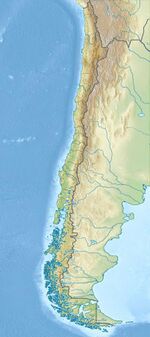Earth:Purilactis Group
| Purilactis Group Stratigraphic range: Upper Cretaceous–Upper Eocene | |
|---|---|
| Type | Geological group |
| Unit of | Salar de Atacama basin |
| Lithology | |
| Primary | Conglomerate, basaltic andesite lava, rhyolitic ignimbrite |
| Other | Gypsum |
| Location | |
| Coordinates | [ ⚑ ] : 22°45′56″S 68°27′47″W / 22.76556°S 68.46306°W |
| Region | Antofagasta Region |
| Country | Chile |
Purilactis Group (Spanish: Grupo Purilactis) is a heterogeneous group of volcanic, volcano-sedimentary and formations of Cretaceous to Eocene age in Salar de Atacama basin, northern Chile .[1] The group has a stratigraphic thickness of more than 6000 m.[1] The group overlies basement rocks of Late Paleozoic age.[1][2] The north-south El Bordo Escarpment of Cordillera Domeyko contain the main outcrops of the group.[1] The group has been difficult to date in detail since it hosts few fossils and dateable minerals.[1] The sediments of the group deposited when volcanism in the area was mainly occurring to the west of it, rather than to east as in the present-day. In geological terms this qualifies the basin as a back-arc basin.[2]
From top to bottom, the main units (formations) of the group outlined by Mpodozis and co-worders in 1999 are:[1]
- Cerro Puntiagudo Strata
- Loma Amarilla Strata
- "Orange" Unit
- Cerro Totola Strata
- Barros Arana Strata
- Purilactis Formation
- Río Grande Member
- Serilao Member
- Vizcachita Member
- Licán Member
- Limón Verde Member
- Tonel Formation
Tonel Formation is separated from Purilactis Formation by a fault, while the remaining first-order units are separated from each other by disconformities.[1] The Tonel Formation exhibit at some localities diapirism in its gypsum layers.[2] Tectonic movements have tilted the northern part of Purilactis Group into an near-vertical position with the stratigraphically higher parts being located in the east.[2] Other tectonic movements have thrust the older Paleozoic basement over the top of the southern part of the Purilactis Group.[2] These movements account to a phase of tectonic inversion beloning to the "Incaic Phase" of the Andean orogeny.[3]
References
- ↑ Jump up to: 1.0 1.1 1.2 1.3 1.4 1.5 1.6 Cite error: Invalid
<ref>tag; no text was provided for refs namedMpoetal1999 - ↑ Jump up to: 2.0 2.1 2.2 2.3 2.4 Charrier, Reynaldo; Reutter, Klaus-J. (1990). "The Purilactis Group of Northern Chile: Boundary Between Arc and Backarc from Late Cretaceous to Eocene". in Reutter, Klaus-Joachim. Tectonics of the Southern Central Andes. Springer, Berlin, Heidelberg. pp. 189–202. doi:10.1007/978-3-642-77353-2. ISBN 978-3-642-77353-2. https://link.springer.com/book/10.1007/978-3-642-77353-2.
- ↑ Flint, Stephen S.; Hartley, A.J.; Rex, David C.; Guise, P.; Turner, Peter (1989). "Geochronology of the Purilactis Formation, Northern Chile: an insight into late cretaceous/early tertiary basin dynamics of the central Andes". Revista Geológica de Chile 16 (2): 241–246. http://www.andeangeology.cl/index.php/revista1/article/view/V16n2-a07.
 |


